
The number known to be infected by the pig-borne disease in southwest China's Sichuan Province that has killed 27 farmers so far was confirmed to have risen to 131 by noon yesterday, according to the Ministry of Health, and it has spread to six unidentified towns in previously unaffected areas.
Though this was an increase of 14 on the day before, the ministry stressed that 12 of the newly reported cases were of people falling ill several days ago.
Cases of human infection had only previously been reported in the cities of Ziyang and Neijiang, and officials said the six cases diagnosed outside them had only come to light after local governments stepped up efforts to identify infected people.
The first known patient was admitted to Ziyang No.3 People’s Hospital on June 24, and since then no human-to-human transmission has been confirmed, said Ministry of Health spokesperson Mao Qun'an.
Xu Jianguo, Center for Disease Prevention and Control epidemic prevention expert, was quoted by Xinhua News Agency today saying that the Streptococcus suis bacterium in infected pigs has been confirmed as having the same genetic sequence as those in infected people.
Pork sales are expected to continue to be hit as cases of the disease continue to rise, but officials in Nanjing and Beijing maintained that the outbreak would pose no permanent threat to either the industry or humans in the long run.
"We have the technology and procedures to bring the disease under control," a Ministry of Agriculture official named Wang said yesterday. "We have already developed pig vaccines, though we have not produced them for a long while."
Two factories, one in Guangzhou in the southern province of Guangdong and another in Sichuan, are mass-producing the pig vaccines, said Yao Huochun, an associate professor at Nanjing Agricultural University’s College of Veterinary Medicine.
Lu Chengping, president of the college’s graduate school, said healthy pigs commonly carry the bacteria with no threat to human health, and that people are only likely to contract the disease from slaughtering or handling pigs that are sick or that have died from the infection.
Lu and Yao participated in the investigation of a 1998 outbreak of the infection in Nantong, in east China's Jiangsu Province.
There, patients exhibited the same symptoms as those in Sichuan of a high fever, bleeding under the skin and toxic shock and "a few" patients died, but they did not reveal exact figures.
Although some have blamed the current epidemic on unsanitary conditions in small-scale pig farms combined with hot temperatures, Yao said experts had yet to determine what specifically triggered the outbreak.
"I hope more money and personnel will be pooled to study the infection and find out what other animals may carry and transmit the bacteria," he said.
The Ministry of Health issued a national guideline yesterday explaining the symptoms of the disease, how to treat patients and prevent and control the epidemic.
(China Daily, Xinhua News Agency July 28, 2005)
|

